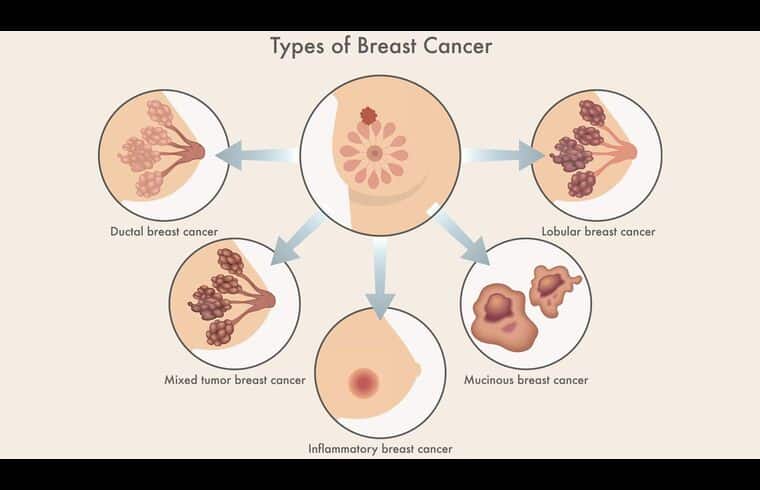Breast cancer is a complex disease where abnormal cells in the breast multiply uncontrollably, forming tumors that may become metastatic breast cancer if they spread to other organs. It can affect both women and men, though women are at much higher risk. Common early signs include a breast lump, nipple discharge, or skin changes. Risk factors include family history of breast cancer, age, obesity, and hormonal shifts like late menopause. Genetics also play a role, especially mutations like BRCA1 and BRCA2. Understanding the stages of breast cancer, knowing when symptoms begin, and recognizing what it causes are essential for early diagnosis and treatment. Depending on the stage, options like breast cancer surgery, chemotherapy, radiation, and hormone therapy may be recommended. Raising breast cancer awareness and promoting regular screenings can improve prognosis and reduce recurrence risks. This guide covers symptoms, causes, types, and treatment options to help you stay informed.
🔍 What Is Breast Cancer?
Breast cancer develops when abnormal cells in the breast begin to divide and form a lump or tumor. These cells can eventually spread to other parts of the body through the lymphatic system or bloodstream.
Not all lumps are cancerous, but any noticeable change in your breast should be checked by a healthcare provider. For more health-related insights, visit our Health and Wellness blog.
⚠️ Common Symptoms of Breast Cancer
Knowing the symptoms can help you catch breast cancer in its early stages. These include:
-
A lump or thickened area in the breast or underarm
-
Changes in breast size or shape
-
Skin dimpling or puckering
-
Inverted nipple or nipple pain
-
Discharge, especially if bloody
-
Redness or flaking skin on the breast or nipple
If you’re experiencing any of these, don’t wait—get screened.
🧪 What Causes Breast Cancer?
The exact causes aren’t always known, but several risk factors increase the likelihood:
-
Age – Risk increases after 50
-
Family history – Especially if close relatives had it
-
Inherited genes, Such as BRCA1 and BRCA2 mutations
-
Hormonal exposure – Early menstruation, late menopause, or hormone therapy
-
Lifestyle – Alcohol, obesity, and inactivity
-
Reproductive history – Not having children or having them later in life
For a deeper dive into hormone-related conditions and balance, check out our Women’s Health articles.
📊 Understanding the Stages of Breast Cancer
Breast cancer stages are determined by how far the disease has spread:
-
Stage 0: Non-invasive; confined to ducts (DCIS)
-
Stage I: Small tumor, limited spread
-
Stage II: Larger tumor and/or spread to lymph nodes
-
Stage III: Spread beyond the breast to nearby tissues
-
Stage IV: Metastatic—spread to organs like the lungs or liver
Staging helps doctors create the most effective treatment plan. Knowing the stages also helps with understanding prognosis and next steps.
💉 How Is Breast Cancer Treated?
Treatment varies based on the stage and type of breast cancer:
-
Surgery: Removes the tumor (lumpectomy) or the entire breast (mastectomy)
-
Radiation therapy: Targets cancer cells with high-energy rays
-
Chemotherapy: Uses drugs to kill or slow cancer growth
-
Hormone therapy: Blocks hormones that help certain cancers grow
-
Targeted therapy: Focuses on specific cancer cell mechanisms
Looking into recovery support? Our Health and Wellness section offers insights into lifestyle and nutritional support for those undergoing or recovering from cancer treatments.
👨 Breast Cancer in Men
Yes, men can develop breast cancer, too. While rare, the symptoms are similar:
-
A lump behind the nipple
-
Nipple changes
-
Discharge or swelling
Because male breast cancer is less publicized, it’s often diagnosed later. Awareness saves lives.
✅ Can You Prevent Breast Cancer?
While there’s no guaranteed prevention, you can reduce your risk:
-
Maintain a healthy weight
-
Stay physically active
-
Eat a balanced diet
-
Limit alcohol
-
Breastfeed, if possible
-
Schedule regular mammograms
We also discuss immune system support and nutritional guidance in our Wellness Resources.
🤔 FAQs About Breast Cancer
What is the first sign of breast cancer?
Often a painless lump, but can also include nipple changes or skin dimpling.
Is breast cancer genetic?
It can be. Inherited gene mutations (like BRCA1 and BRCA2) significantly raise the risk.
Can men get breast cancer?
Yes. While rare, men are also at risk and should take symptoms seriously.
What are the types of treatment?
Surgery, chemotherapy, radiation, and hormone or targeted therapies, depending on the cancer type and stage.
Final Thoughts 💬
🩺 Being informed about breast cancer empowers you to take action—whether through early detection, understanding risk, or knowing when to seek help.

